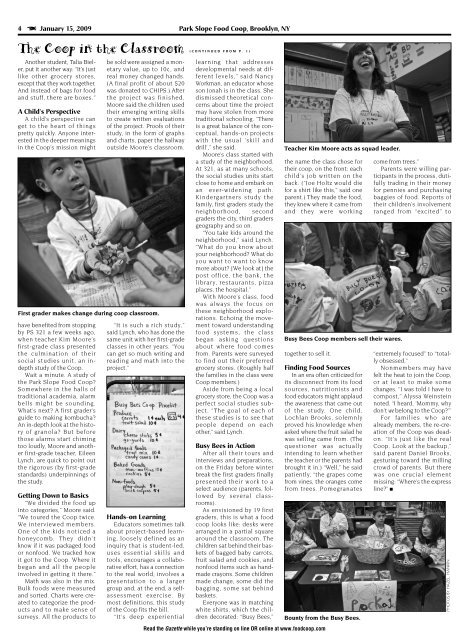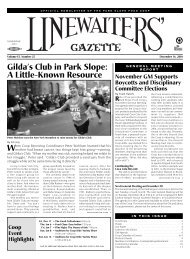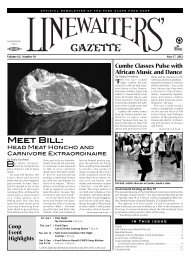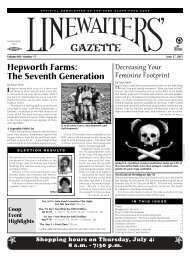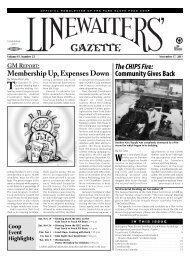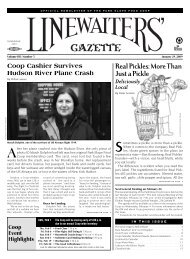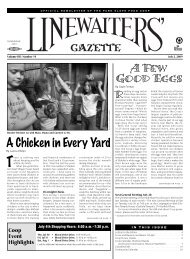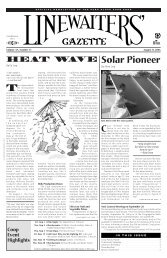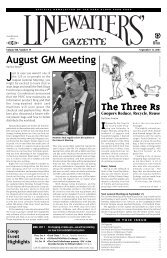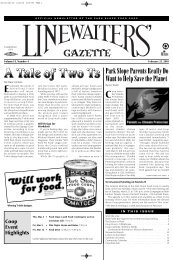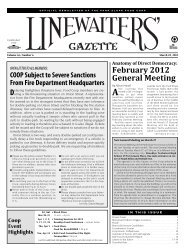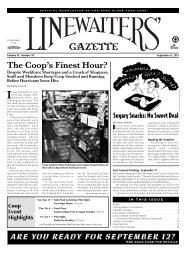The Coop in the Classroom - Park Slope Food Coop
The Coop in the Classroom - Park Slope Food Coop
The Coop in the Classroom - Park Slope Food Coop
Create successful ePaper yourself
Turn your PDF publications into a flip-book with our unique Google optimized e-Paper software.
09-01-15 p 01-16 1/14/09 6:37 PM Page 4<br />
4 January 15, 2009 <strong>Park</strong> <strong>Slope</strong> <strong>Food</strong> <strong>Coop</strong>, Brooklyn, NY<br />
<strong>The</strong> <strong>Coop</strong> <strong>in</strong> <strong>the</strong> <strong>Classroom</strong><br />
Ano<strong>the</strong>r student, Talia Bieler,<br />
put it ano<strong>the</strong>r way: “It’s just<br />
like o<strong>the</strong>r grocery stores,<br />
except that <strong>the</strong>y work toge<strong>the</strong>r.<br />
And <strong>in</strong>stead of bags for food<br />
and stuff, <strong>the</strong>re are boxes.”<br />
A Child’s Perspective<br />
A child’s perspective can<br />
get to <strong>the</strong> heart of th<strong>in</strong>gs<br />
pretty quickly. Anyone <strong>in</strong>terested<br />
<strong>in</strong> <strong>the</strong> deeper mean<strong>in</strong>gs<br />
<strong>in</strong> <strong>the</strong> <strong>Coop</strong>’s mission might<br />
have benefited from stopp<strong>in</strong>g<br />
by PS 321 a few weeks ago,<br />
when teacher Kim Moore’s<br />
first-grade class presented<br />
<strong>the</strong> culm<strong>in</strong>ation of <strong>the</strong>ir<br />
social studies unit, an <strong>in</strong>depth<br />
study of <strong>the</strong> <strong>Coop</strong>.<br />
Wait a m<strong>in</strong>ute. A study of<br />
<strong>the</strong> <strong>Park</strong> <strong>Slope</strong> <strong>Food</strong> <strong>Coop</strong><br />
Somewhere <strong>in</strong> <strong>the</strong> halls of<br />
traditional academia, alarm<br />
bells might be sound<strong>in</strong>g.<br />
What’s next A first grader’s<br />
guide to mak<strong>in</strong>g kombucha<br />
An <strong>in</strong>-depth look at <strong>the</strong> history<br />
of granola But before<br />
those alarms start chim<strong>in</strong>g<br />
too loudly, Moore and ano<strong>the</strong>r<br />
first-grade teacher, Eileen<br />
Lynch, are quick to po<strong>in</strong>t out<br />
<strong>the</strong> rigorous (by first-grade<br />
standards) underp<strong>in</strong>n<strong>in</strong>gs of<br />
<strong>the</strong> study.<br />
Gett<strong>in</strong>g Down to Basics<br />
“We divided <strong>the</strong> food up<br />
<strong>in</strong>to categories,” Moore said.<br />
“We toured <strong>the</strong> <strong>Coop</strong> twice.<br />
We <strong>in</strong>terviewed members.<br />
One of <strong>the</strong> kids noticed a<br />
honeycomb. <strong>The</strong>y didn’t<br />
know if it was packaged food<br />
or nonfood. We tracked how<br />
it got to <strong>the</strong> <strong>Coop</strong>. Where it<br />
began and all <strong>the</strong> people<br />
<strong>in</strong>volved <strong>in</strong> gett<strong>in</strong>g it <strong>the</strong>re.”<br />
Math was also <strong>in</strong> <strong>the</strong> mix.<br />
Bulk foods were measured<br />
and sorted. Charts were created<br />
to categorize <strong>the</strong> products<br />
and to make sense of<br />
surveys. All <strong>the</strong> products to<br />
be sold were assigned a monetary<br />
value, up to 10¢, and<br />
real money changed hands.<br />
(A f<strong>in</strong>al profit of about $20<br />
was donated to CHIPS.) After<br />
<strong>the</strong> project was f<strong>in</strong>ished,<br />
Moore said <strong>the</strong> children used<br />
<strong>the</strong>ir emerg<strong>in</strong>g writ<strong>in</strong>g skills<br />
to create written evaluations<br />
of <strong>the</strong> project. Proofs of <strong>the</strong>ir<br />
study, <strong>in</strong> <strong>the</strong> form of graphs<br />
and charts, paper <strong>the</strong> hallway<br />
outside Moore’s classroom.<br />
First grader makes change dur<strong>in</strong>g coop classroom.<br />
“It is such a rich study,”<br />
said Lynch, who has done <strong>the</strong><br />
same unit with her first-grade<br />
classes <strong>in</strong> o<strong>the</strong>r years. “You<br />
can get so much writ<strong>in</strong>g and<br />
read<strong>in</strong>g and math <strong>in</strong>to <strong>the</strong><br />
project.”<br />
Hands-on Learn<strong>in</strong>g<br />
Educators sometimes talk<br />
about project-based learn<strong>in</strong>g,<br />
loosely def<strong>in</strong>ed as an<br />
<strong>in</strong>quiry that is student-led,<br />
uses essential skills and<br />
tools, encourages a collaborative<br />
effort, has a connection<br />
to <strong>the</strong> real world, <strong>in</strong>volves a<br />
presentation to a larger<br />
group and, at <strong>the</strong> end, a selfassessment<br />
exercise. By<br />
most def<strong>in</strong>itions, this study<br />
of <strong>the</strong> <strong>Coop</strong> fits <strong>the</strong> bill.<br />
“It’s deep experiential<br />
(CONTINUED FROM P. 1)<br />
learn<strong>in</strong>g that addresses<br />
developmental needs at different<br />
levels,” said Nancy<br />
Workman, an educator whose<br />
son Jonah is <strong>in</strong> <strong>the</strong> class. She<br />
dismissed <strong>the</strong>oretical concerns<br />
about time <strong>the</strong> project<br />
may have stolen from more<br />
traditional school<strong>in</strong>g. “<strong>The</strong>re<br />
is a great balance of <strong>the</strong> conceptual,<br />
hands-on projects<br />
with <strong>the</strong> usual ‘skill and<br />
drill’,” she said.<br />
Moore’s class started with<br />
a study of <strong>the</strong> neighborhood.<br />
At 321, as at many schools,<br />
<strong>the</strong> social studies units start<br />
close to home and embark on<br />
an ever-widen<strong>in</strong>g path.<br />
K<strong>in</strong>dergartners study <strong>the</strong><br />
family, first graders study <strong>the</strong><br />
neighborhood, second<br />
graders <strong>the</strong> city, third graders<br />
geography and so on.<br />
“You take kids around <strong>the</strong><br />
neighborhood,” said Lynch.<br />
“What do you know about<br />
your neighborhood What do<br />
you want to want to know<br />
more about [We look at] <strong>the</strong><br />
post office, <strong>the</strong> bank, <strong>the</strong><br />
library, restaurants, pizza<br />
places, <strong>the</strong> hospital.”<br />
With Moore’s class, food<br />
was always <strong>the</strong> focus on<br />
<strong>the</strong>se neighborhood explorations.<br />
Echo<strong>in</strong>g <strong>the</strong> movement<br />
toward understand<strong>in</strong>g<br />
food systems, <strong>the</strong> class<br />
began ask<strong>in</strong>g questions<br />
about where food comes<br />
from. Parents were surveyed<br />
to f<strong>in</strong>d out <strong>the</strong>ir preferred<br />
grocery stores. (Roughly half<br />
<strong>the</strong> families <strong>in</strong> <strong>the</strong> class were<br />
<strong>Coop</strong> members.)<br />
Aside from be<strong>in</strong>g a local<br />
grocery store, <strong>the</strong> <strong>Coop</strong> was a<br />
perfect social studies subject.<br />
“<strong>The</strong> goal of each of<br />
<strong>the</strong>se studies is to see that<br />
people depend on each<br />
o<strong>the</strong>r,” said Lynch.<br />
Busy Bees <strong>in</strong> Action<br />
After all <strong>the</strong>ir tours and<br />
<strong>in</strong>terviews and preparations,<br />
on <strong>the</strong> Friday before w<strong>in</strong>ter<br />
break <strong>the</strong> first graders f<strong>in</strong>ally<br />
presented <strong>the</strong>ir work to a<br />
select audience (parents, followed<br />
by several classrooms).<br />
As envisioned by 19 first<br />
graders, this is what a food<br />
coop looks like: desks were<br />
arranged <strong>in</strong> a partial square<br />
around <strong>the</strong> classroom. <strong>The</strong><br />
children sat beh<strong>in</strong>d <strong>the</strong>ir baskets<br />
of bagged baby carrots,<br />
fruit salad and cookies, and<br />
nonfood items such as handmade<br />
crayons. Some children<br />
made change, some did <strong>the</strong><br />
bagg<strong>in</strong>g, some sat beh<strong>in</strong>d<br />
baskets.<br />
Everyone was <strong>in</strong> match<strong>in</strong>g<br />
white shirts, which <strong>the</strong> children<br />
decorated: “Busy Bees,”<br />
Teacher Kim Moore acts as squad leader.<br />
<strong>the</strong> name <strong>the</strong> class chose for<br />
<strong>the</strong>ir coop, on <strong>the</strong> front; each<br />
child’s job written on <strong>the</strong><br />
back. (“Joe Holtz would die<br />
for a shirt like this,” said one<br />
parent.) <strong>The</strong>y made <strong>the</strong> food,<br />
<strong>the</strong>y knew where it came from<br />
and <strong>the</strong>y were work<strong>in</strong>g<br />
Busy Bees <strong>Coop</strong> members sell <strong>the</strong>ir wares.<br />
toge<strong>the</strong>r to sell it.<br />
F<strong>in</strong>d<strong>in</strong>g <strong>Food</strong> Sources<br />
In an era often criticized for<br />
its disconnect from its food<br />
sources, nutritionists and<br />
food educators might applaud<br />
<strong>the</strong> awareness that came out<br />
of <strong>the</strong> study. One child,<br />
Lochlan Brooks, solemnly<br />
proved his knowledge when<br />
asked where <strong>the</strong> fruit salad he<br />
was sell<strong>in</strong>g came from. (<strong>The</strong><br />
questioner was actually<br />
<strong>in</strong>tend<strong>in</strong>g to learn whe<strong>the</strong>r<br />
<strong>the</strong> teacher or <strong>the</strong> parents had<br />
brought it <strong>in</strong>.) “Well,” he said<br />
patiently, “<strong>the</strong> grapes come<br />
from v<strong>in</strong>es, <strong>the</strong> oranges come<br />
from trees. Pomegranates<br />
Bounty from <strong>the</strong> Busy Bees.<br />
Read <strong>the</strong> Gazette while you’re stand<strong>in</strong>g on l<strong>in</strong>e OR onl<strong>in</strong>e at www.foodcoop.com<br />
come from trees.”<br />
Parents were will<strong>in</strong>g participants<br />
<strong>in</strong> <strong>the</strong> process, dutifully<br />
trad<strong>in</strong>g <strong>in</strong> <strong>the</strong>ir money<br />
for pennies and purchas<strong>in</strong>g<br />
baggies of food. Reports of<br />
<strong>the</strong>ir children’s <strong>in</strong>volvement<br />
ranged from “excited” to<br />
“extremely focused” to “totally<br />
obsessed.”<br />
Nonmembers may have<br />
felt <strong>the</strong> heat to jo<strong>in</strong> <strong>the</strong> <strong>Coop</strong>,<br />
or at least to make some<br />
changes. “I was told I have to<br />
compost,” Alyssa We<strong>in</strong>ste<strong>in</strong><br />
noted. “I heard, ‘Mommy, why<br />
don’t we belong to <strong>the</strong> <strong>Coop</strong>’”<br />
For families who are<br />
already members, <strong>the</strong> re-creation<br />
of <strong>the</strong> <strong>Coop</strong> was deadon.<br />
“It’s just like <strong>the</strong> real<br />
<strong>Coop</strong>. Look at <strong>the</strong> backup,”<br />
said parent Daniel Brooks,<br />
gestur<strong>in</strong>g toward <strong>the</strong> mill<strong>in</strong>g<br />
crowd of parents. But <strong>the</strong>re<br />
was one crucial element<br />
miss<strong>in</strong>g: “Where’s <strong>the</strong> express<br />
l<strong>in</strong>e” ■<br />
PHOTOS BY HAZEL HANKIN


